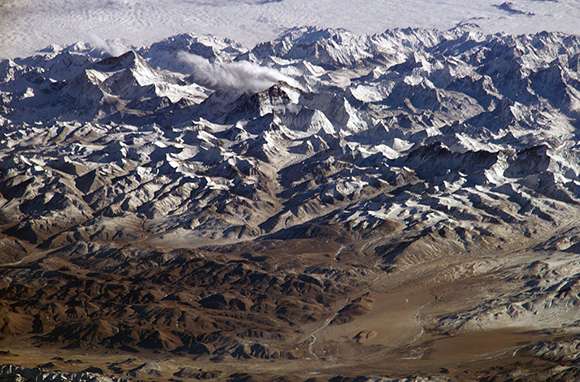Climate model tagging technique tracks snowpack-melting particles

Airborne soot from fires, burning fossil fuels, and other sources can threaten water supplies in mountainous regions far from the burning source. Now, a new method developed at Pacific Northwest National Laboratory tagged sources of soot from different global regions in a climate model, and tracked where it lands on China's Tibetan Plateau. Researchers determined which areas around the plateau contributed the most soot-and where. The technique also pointed to the most effective way to reduce soot on the plateau to ease the amount of warming the region undergoes.
"Soot on snow in the northwest plateau causes more warming than all other sources in the area. It's bigger than the effect of greenhouse gases and soot in the atmosphere," said corresponding author and PNNL atmospheric scientist Dr. Hailong Wang. "The strong heating caused by soot on snow and in the atmosphere can change air circulation over the Plateau, leading to a broader impact on climate."
Like a dark blanket, the soot acts to warm the ice and snow enough to speed up snowmelt and shrink glaciers. The study confirmed previous work that soot causes net warming over the entire Himalayan-Tibetan Plateau region. The work showed that soot pollution could affect the people living there by altering the seasonal water supply. By pinpointing sources of soot that would make the biggest difference when cut, the study points to areas where cutting pollution could provide a large impact.
"If we really want to address the issue of soot on the Tibetan Plateau," said Dr. Yun Qian, a study co-author and atmospheric scientist at PNNL, "we need to know where we should start."
Although earlier work showed soot's warming effect over the whole region, the researchers wanted to pinpoint what kind of sources contribute. The team looked specifically at fossil fuel sources, biofuel and biomass sources of soot. For example, people in the surrounding countries use much wood, grass and agricultural wastes to cook with, which the team categorized as biofuel.
To track soot, the team developed a new way to tag particles emitted from individual sources within the climate model. This was an improvement on the other source-attribution methods that either don't completely isolate contributions from particular sources or they require running the model many times in order to turn the sources off and on one at a time. Running the computer model in this way not only showed which source sent the most soot over, but also can determine which source would make the biggest impact if emissions are cut. The soot destination that changed the most was the northwest Plateau by cuts in central Asia's fossil fuel burning. Cuts in South Asia can effectively reduce the soot level on the entire plateau, especially in the Himalayas.
As part of the same project, this new technique is also being used to explore sources and impacts of heat-trapping soot particles in snow over North America. The team is also planning to evaluate the effect of different pollution mitigation scenarios on long-term changes in snow cover and fresh water supply.
More information: "Quantifying sources, transport, deposition, and radiative forcing of black carbon over the Himalayas and Tibetan Plateau," Atmospheric Chemistry and Physics 15(11): 6205-6223. DOI: 10.5194/acp-15-6205-2015
Journal information: Atmospheric Chemistry and Physics
Provided by Pacific Northwest National Laboratory




















